The White Eagles: Polish Aviation 1918-1920
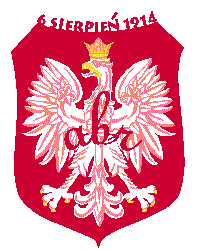 In 1914,
Poland was a dream, not a geopolitical reality. The disastrous War of the Polish
Succession issued in the partition of the ancient, Catholic kingdom. Austria took
Galicia in the southwest. Protestant Germany annexed Silesia and parts of the Polish
Baltic. Reactionary, Orthodox Russia siezed the rest and ruled it harshly. From time
to time, inspired by enthusiasm for Chopin or the polka, romantics, idealists, and
eccentrics of various stripes championed Polish independence, particularly during the
effusion of nationalist sentiment that swept Europe in the nineteenth century. For a time,
under Napoleon, the nation even enjoyed a nominal independence and a considerable vogue
in fashionable circles. But, in practical diplomatic or military matters, Polish patriots
were invariably on their own and at the mercy of foreign guns. In simple terms,
Poland had ceased to exist for the Great Powers. They had long since decided her
fate and had no desire to reopen an issue that might lead to considerable bother and expense.
In 1914,
Poland was a dream, not a geopolitical reality. The disastrous War of the Polish
Succession issued in the partition of the ancient, Catholic kingdom. Austria took
Galicia in the southwest. Protestant Germany annexed Silesia and parts of the Polish
Baltic. Reactionary, Orthodox Russia siezed the rest and ruled it harshly. From time
to time, inspired by enthusiasm for Chopin or the polka, romantics, idealists, and
eccentrics of various stripes championed Polish independence, particularly during the
effusion of nationalist sentiment that swept Europe in the nineteenth century. For a time,
under Napoleon, the nation even enjoyed a nominal independence and a considerable vogue
in fashionable circles. But, in practical diplomatic or military matters, Polish patriots
were invariably on their own and at the mercy of foreign guns. In simple terms,
Poland had ceased to exist for the Great Powers. They had long since decided her
fate and had no desire to reopen an issue that might lead to considerable bother and expense.
The impending World War seemed likely to change all that in an instant. The bother and
expense was already upon Europe's leaders, who now avidly sought allies great and small. The
time seemed right for Poland to again exert herself. She might now make her freedom the price
of her support for one of the combatant powers or at least weaken her enemies by turning them
against one another. Noting the growing antagonism between Austria and Russia and cognizant of
Germany's designs on the latter, a militant nationalist, former socialist, and future military
dictator named Joseph Pilsudski organized and led a series of Polish Legions under the Austrian
banner. Many of his compatriots took the more traditional route and went west, to Paris, where
they served with the French Foreign Legion or, in time, with the forces of a Polish government
in exile. Others entered Russia's own Polish Legions, hoping to win by loyalty what they had
never been able to sieze by force of arms.
The near simultaneous defeat of the Central Powers and the collapse of Russia into anarchy
and revolution seemed to vindicate this thinking. The powers that had divided Poland in a
gentlemen's agreement 123 years earlier had now defeated one another. Accordingly, on 9 November
1918, Poland proclaimed herself a republic, with Pilsudski as head of state and the famous pianist, Jan
Paderewski as premier. The future seemed secure at last.
 Unfortunately, a tradition of
nationalist extremism and an intolerance born of long service in
the Austrian and Prussian armies had made Poland's new leaders intransigent and aggressive. When the
Versailles Treaty accepted the recommendations of the Curzon Commission and settled Poland's eastern
border in Russia's favor, well to the west, the Polish government reacted violently. It demanded
all territory that had been Polish prior to the partition of 1772, even though most the residents in
these lands were ethnic Belorussians or Ukrainians. Then it went on to claim newly independent
Lithuania's ancient capital, Vilnius, and Czechoslovakia's Teschen region on ethnic grounds, even
though the latter had never been part of Poland. Poland's leaders were, moreover, ready and eager
to use force in support of this inconsistent, neo-imperialist policy. War with Soviet Russia,
Lithuania, and Czechoslovakia quickly followed.
Unfortunately, a tradition of
nationalist extremism and an intolerance born of long service in
the Austrian and Prussian armies had made Poland's new leaders intransigent and aggressive. When the
Versailles Treaty accepted the recommendations of the Curzon Commission and settled Poland's eastern
border in Russia's favor, well to the west, the Polish government reacted violently. It demanded
all territory that had been Polish prior to the partition of 1772, even though most the residents in
these lands were ethnic Belorussians or Ukrainians. Then it went on to claim newly independent
Lithuania's ancient capital, Vilnius, and Czechoslovakia's Teschen region on ethnic grounds, even
though the latter had never been part of Poland. Poland's leaders were, moreover, ready and eager
to use force in support of this inconsistent, neo-imperialist policy. War with Soviet Russia,
Lithuania, and Czechoslovakia quickly followed.
Below, LVG C.V No. 9825/17, 17 Squadron, 1920
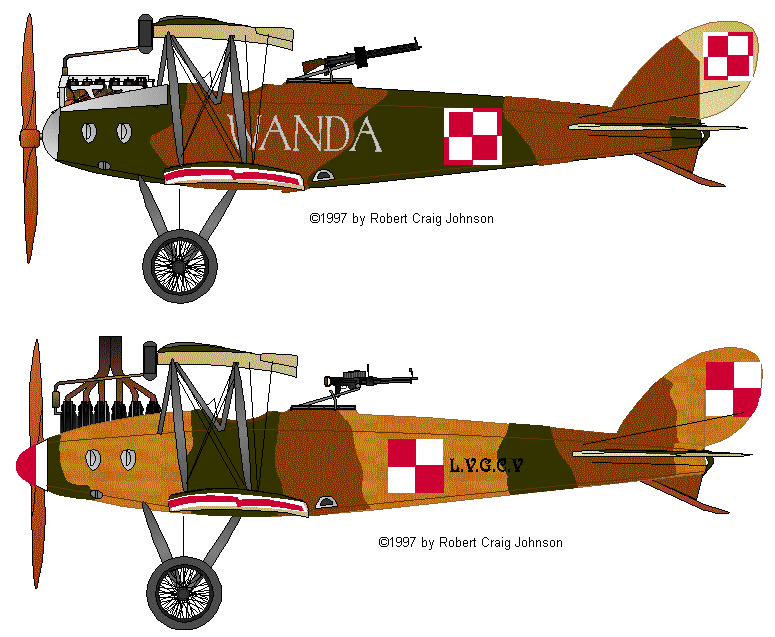
Above, LVG C.V
The resulting fighting was a considerable departure from the norms of 1914-18. The vast distances
and general lack of roads in the east made cavalry the principal fighting arm. The supporting arms—
artillery, supply, and aviation—moved by train, so advances tended to follow the few available rail
lines. Armored trains secured these vital lines of communication and supported the cavalry with
cannon and machine guns.
Below (top), Oeffag-Albatros D.III, Kosciuzko Squadron, 1919-20, in printed sworl camouflage cloth.
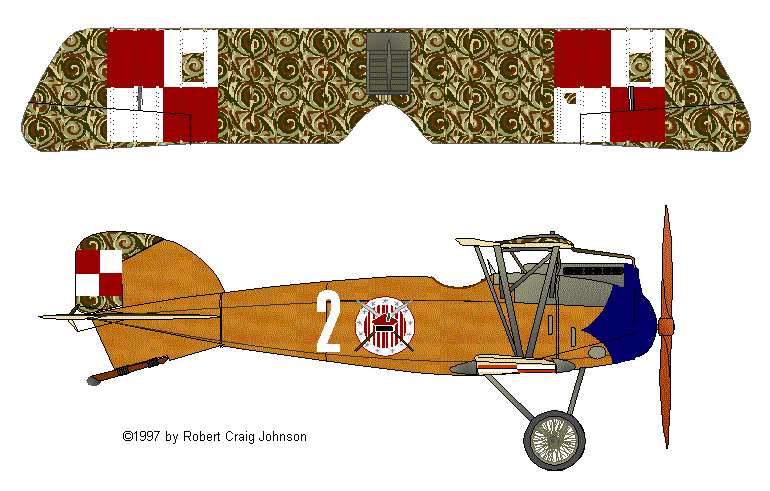
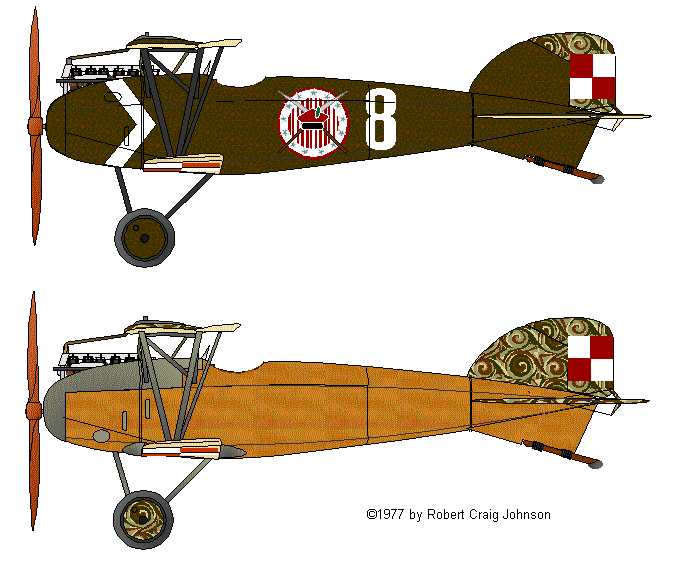
Above (middle), Oeffag-Albatros D.III, Kosciuzko Squadron, 1919, painted in green and brown mottled
"summer-leaf" camouflage with sworl-fabric rudder and upper surfaces(?) Above (middle), Oeffag-Albatros
D.III, with clear-varnished wood fuselage and printed sworl camouflage fabric on all upper surfaces, fin and rudder.
Given the nature of the fighting, reconnaissance was the primary function of aviation in the East.
Good intelligence was crucial during confused flanking actions in open country. Most of the two-seaters thus
served as scouting machines. Aerial confrontations were rare in the vasts spaces of the
border regions, so fighters were used as fighter bombers and attack aircraft. Cavalry and rail traffic proved
particularly vulnerable to strafing with machine guns and light bombs.
Below (top), Oeffag-Albatros D.III, 13 Squadron, 1919-20, painted in green and brown mottled
"summer-leaf" camouflage Below (middle), Oeffag-Albatros D.III, Kosciuzko Squadron, 1919-20, Capt.
Cedric Fauntleroy
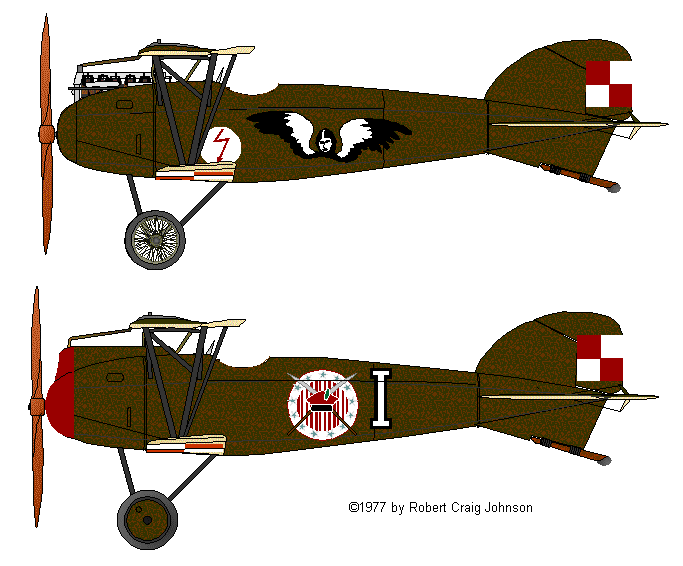
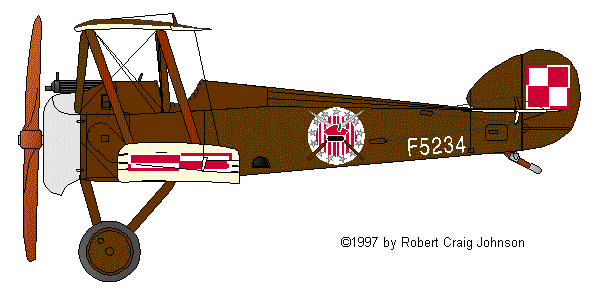
Above, Sopwith Camel, Kosciuzko Squadron, 1919.
Poland's best-known aviation unit was the famous Kosciuzko Squadron, named for the
leader of the 1792 uprising against Russian rule. The pilots were mainly American ex-service pilots (Kosciuzko
had served during America's Revolution). Some were mercenaries, others volunteered after being
caught up in the romantic fervor of the Polish patriots. The Americans were joined by several regular
French units. These contained (or were alleged to contain) substantial contingents of Polish personnel.
Below, Ni. 24bis 4301, Lt. Popov, after white
bands and personal markings were over-doped silver
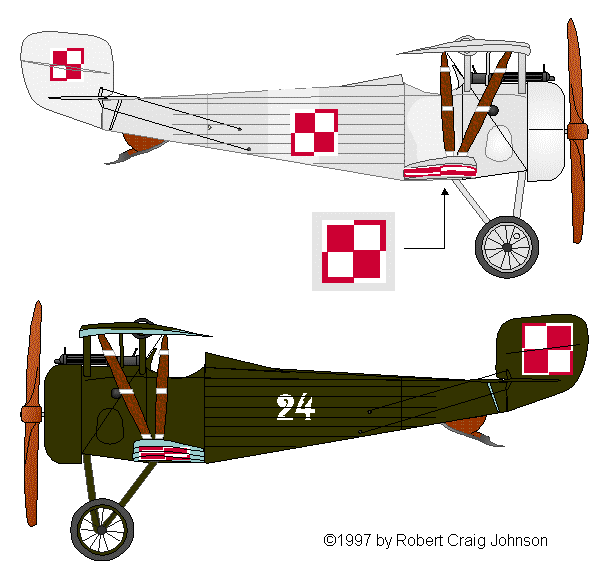
Above, Ni. 24bis, training unit, 1921-22. Below, Ni. 24bis N. 5086, Julius Gilewicz,
5 Squadron, Polish air service.
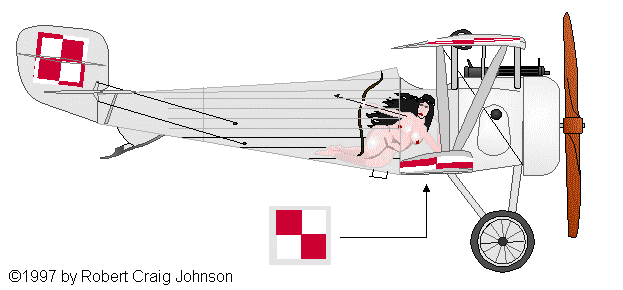
Below, Fokker D VII, 15 Squadron (note the Aldis sight)

Above, Fokker D VII, No. 502/18 (note the light bomb racks) Below, Fokker D VII
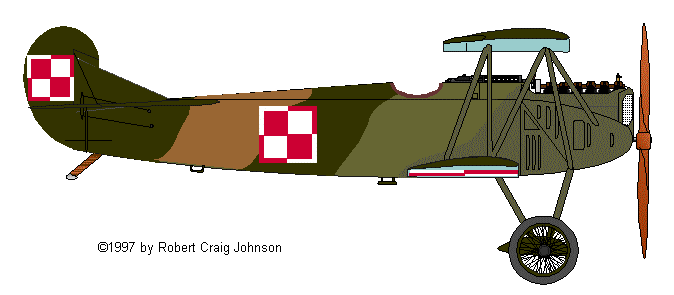
Poland used a heterogenous mixture of equipment scrounged from the arms dumps of Prussia,
Russia, and Austria or rushed from Allied surplus stocks. Initially, Austrian Oeffag-Albatros D.IIIs
were the backbone of the Polish fighter force. These were supplemented by Fokker D.VIIs and D.VIIIs taken
from Germany or her eastern allies and by French types—Nieuports and SPAD 7s—left by the Czar's air force or
captured from the Bolsheviks. A solitary Sopwith Camel served with the Kosciuzko Squadron, but
this was the personal property of its American pilot. German and Austrian two-seaters were used in large numbers.
Once the Allied advisory missions arrived, these types were supplemented by SPAD XIII fighters,
Breguet XIV.A2 reconnaissance machines, and Italian Ansaldo A1 fighters. A number of these aircraft are
illustrated below.
Below, SPAD VII C1
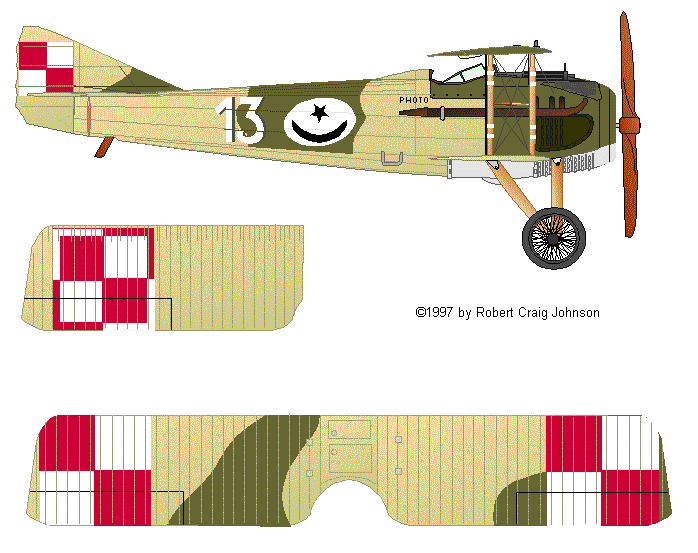
Below, SPAD 7 C1 No. 1473, 2nd Polish Corps, Ukraine, 1918
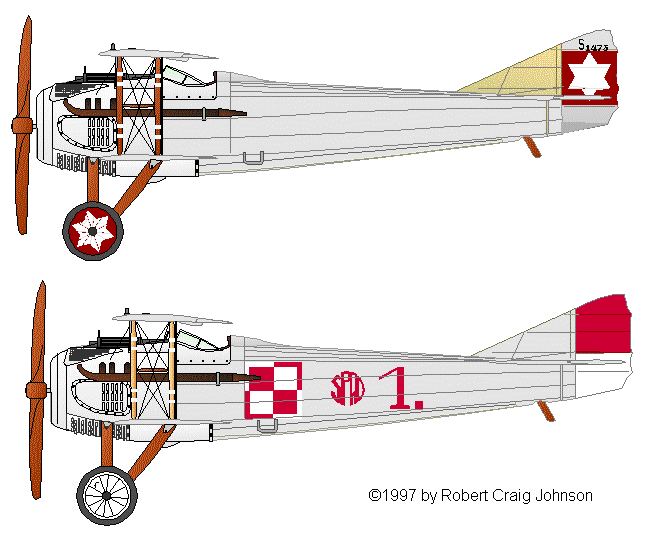
Above, SPAD 7 C1, 7 Squadron, Lvov, 1919
Below, SPAD 7 C1 No. 1473, 2nd Polish Corps, Ukraine, 1918
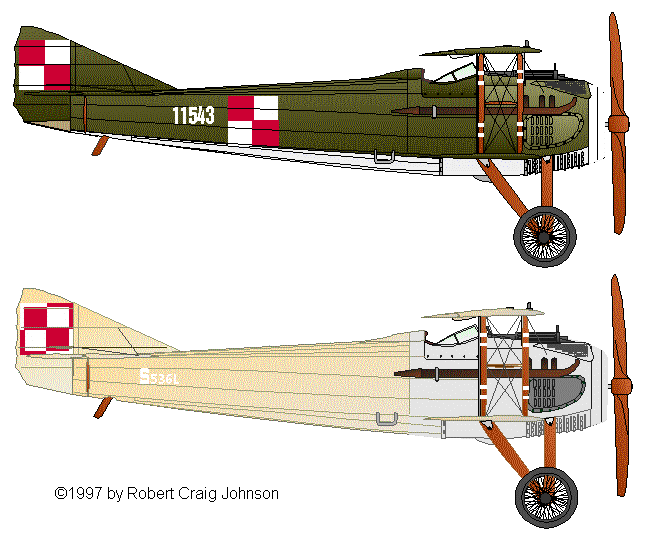
Above, SPAD 7 C1 No. 536L Below (top), LVG C.VI, 4 Squadron, Torun, 1920, with hand-painted
lozenge canouflage on the fuselage Below (middle), LVG C.VI, 8 Squadron, 1919, with
5-color lozenge-camouflage printed fabric on wings, pilot Kazimierz Tomaszewicz
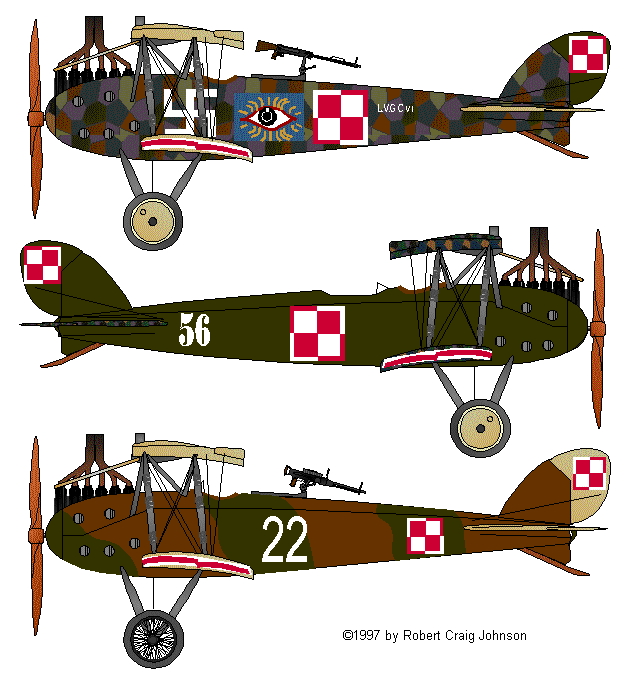
Above, LVG C.VI Below, Ansaldo A.1 Ballila
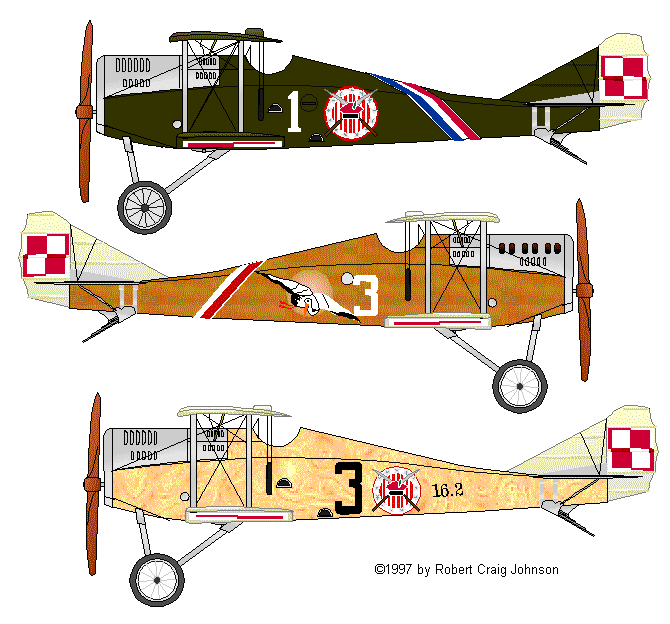
Above (middle), Ansaldo A.1 Ballila, 121 (Kosciuszko) Squadron, pilot Stefan Pawlikowski
Above (middle), Ansaldo A.1 Ballila, 121 (Kosciuszko) Squadron, pilot Cedric Fauntleroy
Below, Hannover Cl.II No. 683/18, 3 Squadron, 1918, with hand-painted lozenge camouflage overall
(note the reconnaissance camera on the rear-cockpit gun ring)
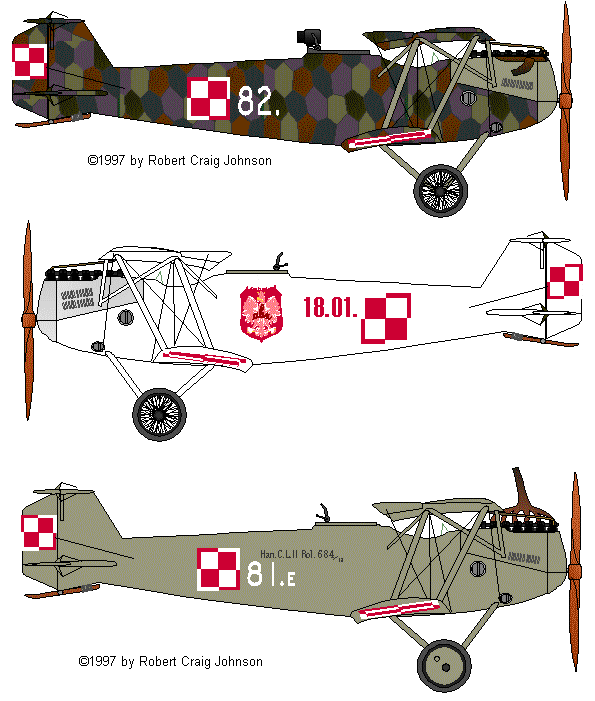
Above (middle), Hannover Cl.II No. 001/19
Above (bottom), Hannover Cl.II (Roland) No. 684/18
Below, Hannover Cl.II No. 218/17
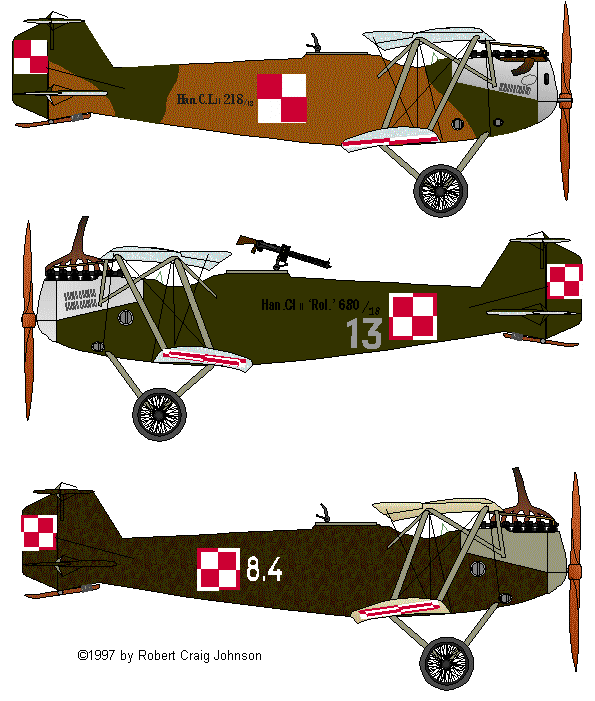
Above (middle), Hannover Cl.II (Roland) No. 680/18
Above (bottom), Hannover Cl.II No. 354, 1919, in Austrian-style autumn-leaf camouflage
Below, Ansaldo A.1 Ballila, 121 (Kosciuszko) Squadron
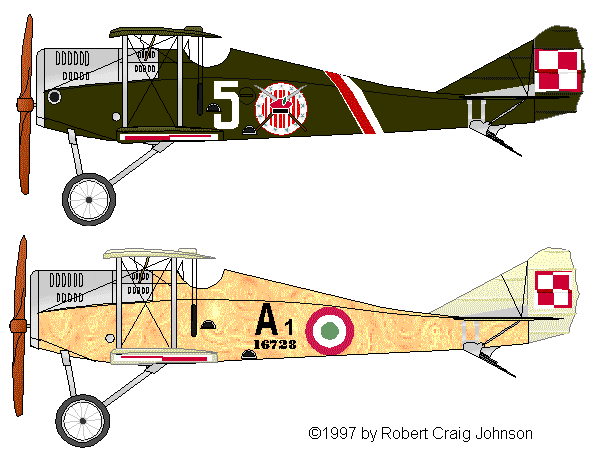
Above, Ansaldo A.1 Ballila No. 16728, 7 Squadron, Warsaw 1920
Below, Halberstadt (BFW) Cl.II No. 2875/18, 2 Squadron
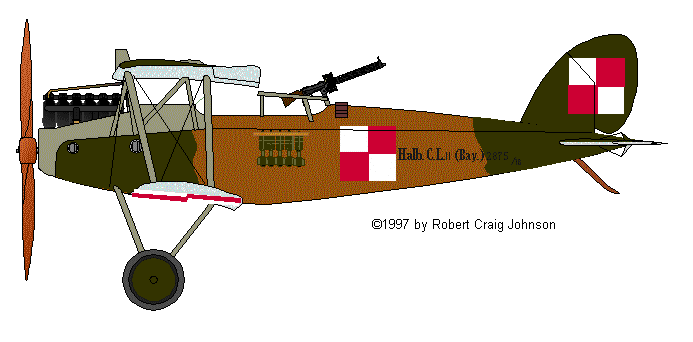
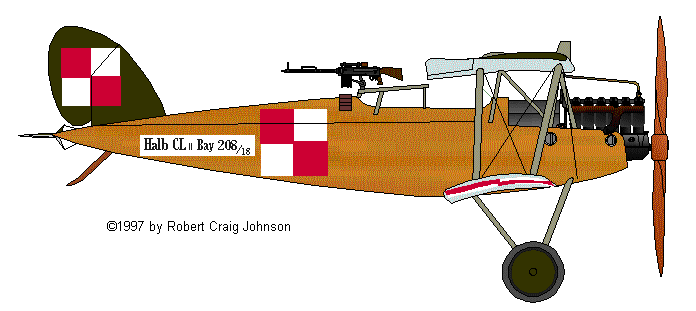
Above, Halberstadt (BFW) Cl.II No. 208/18, 2 Squadron
Below, Breguet XIV A.2, 16 (Recon) Squadron, 1920
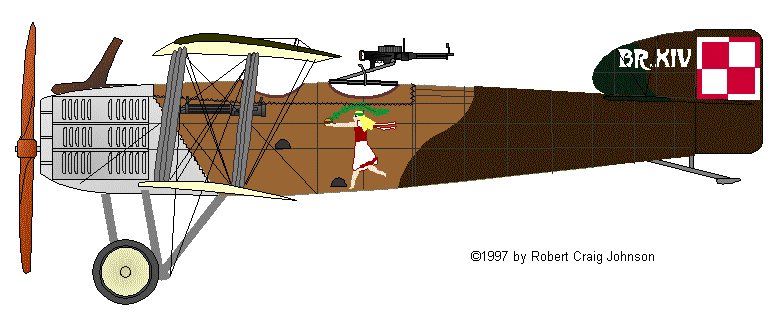
Next page
Return to Table of Contents
© 1997 by Robert Craig Johnson.
 In 1914,
Poland was a dream, not a geopolitical reality. The disastrous War of the Polish
Succession issued in the partition of the ancient, Catholic kingdom. Austria took
Galicia in the southwest. Protestant Germany annexed Silesia and parts of the Polish
Baltic. Reactionary, Orthodox Russia siezed the rest and ruled it harshly. From time
to time, inspired by enthusiasm for Chopin or the polka, romantics, idealists, and
eccentrics of various stripes championed Polish independence, particularly during the
effusion of nationalist sentiment that swept Europe in the nineteenth century. For a time,
under Napoleon, the nation even enjoyed a nominal independence and a considerable vogue
in fashionable circles. But, in practical diplomatic or military matters, Polish patriots
were invariably on their own and at the mercy of foreign guns. In simple terms,
Poland had ceased to exist for the Great Powers. They had long since decided her
fate and had no desire to reopen an issue that might lead to considerable bother and expense.
In 1914,
Poland was a dream, not a geopolitical reality. The disastrous War of the Polish
Succession issued in the partition of the ancient, Catholic kingdom. Austria took
Galicia in the southwest. Protestant Germany annexed Silesia and parts of the Polish
Baltic. Reactionary, Orthodox Russia siezed the rest and ruled it harshly. From time
to time, inspired by enthusiasm for Chopin or the polka, romantics, idealists, and
eccentrics of various stripes championed Polish independence, particularly during the
effusion of nationalist sentiment that swept Europe in the nineteenth century. For a time,
under Napoleon, the nation even enjoyed a nominal independence and a considerable vogue
in fashionable circles. But, in practical diplomatic or military matters, Polish patriots
were invariably on their own and at the mercy of foreign guns. In simple terms,
Poland had ceased to exist for the Great Powers. They had long since decided her
fate and had no desire to reopen an issue that might lead to considerable bother and expense.  Unfortunately, a tradition of
nationalist extremism and an intolerance born of long service in
the Austrian and Prussian armies had made Poland's new leaders intransigent and aggressive. When the
Versailles Treaty accepted the recommendations of the Curzon Commission and settled Poland's eastern
border in Russia's favor, well to the west, the Polish government reacted violently. It demanded
all territory that had been Polish prior to the partition of 1772, even though most the residents in
these lands were ethnic Belorussians or Ukrainians. Then it went on to claim newly independent
Lithuania's ancient capital, Vilnius, and Czechoslovakia's Teschen region on ethnic grounds, even
though the latter had never been part of Poland. Poland's leaders were, moreover, ready and eager
to use force in support of this inconsistent, neo-imperialist policy. War with Soviet Russia,
Lithuania, and Czechoslovakia quickly followed.
Unfortunately, a tradition of
nationalist extremism and an intolerance born of long service in
the Austrian and Prussian armies had made Poland's new leaders intransigent and aggressive. When the
Versailles Treaty accepted the recommendations of the Curzon Commission and settled Poland's eastern
border in Russia's favor, well to the west, the Polish government reacted violently. It demanded
all territory that had been Polish prior to the partition of 1772, even though most the residents in
these lands were ethnic Belorussians or Ukrainians. Then it went on to claim newly independent
Lithuania's ancient capital, Vilnius, and Czechoslovakia's Teschen region on ethnic grounds, even
though the latter had never been part of Poland. Poland's leaders were, moreover, ready and eager
to use force in support of this inconsistent, neo-imperialist policy. War with Soviet Russia,
Lithuania, and Czechoslovakia quickly followed. 


















